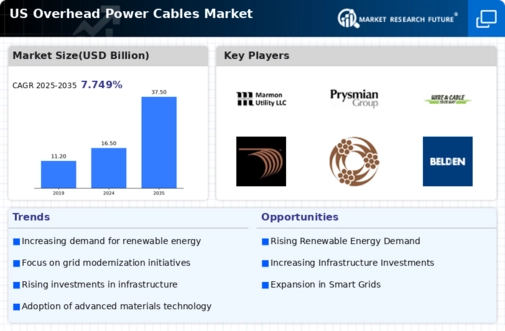Rising Energy Demand
The rising energy demand in the US is a significant driver for the overhead power-cables market. As the population grows and industrial activities expand, the need for reliable and efficient power distribution systems becomes paramount. Projections suggest that electricity consumption in the US could increase by approximately 1.5% annually over the next five years. This escalating demand necessitates the installation of new overhead power cables to ensure that energy can be transmitted effectively from generation sources to end-users. Additionally, the shift towards electric vehicles and renewable energy sources is likely to further amplify energy requirements, thereby increasing the pressure on existing power infrastructure. Consequently, the overhead power-cables market is expected to experience substantial growth as utilities and energy providers invest in expanding and modernizing their networks to meet this rising demand.
Regulatory Compliance and Standards
Regulatory compliance and standards play a crucial role in shaping the overhead power-cables market. The US government has established stringent regulations aimed at ensuring safety, reliability, and environmental sustainability in power distribution. Compliance with these regulations often necessitates the adoption of advanced materials and technologies in overhead power cables. For instance, the National Electrical Code (NEC) outlines specific requirements for cable installation and performance, which manufacturers must adhere to. This regulatory landscape encourages innovation and drives the development of high-quality overhead power cables that meet or exceed these standards. As utilities strive to comply with evolving regulations, the demand for compliant overhead power cables is likely to increase, thereby propelling market growth. The emphasis on safety and environmental considerations further underscores the importance of regulatory compliance in the overhead power-cables market.
Infrastructure Development Initiatives
The ongoing infrastructure development initiatives in the US are poised to bolster the overhead power-cables market. With the government allocating substantial funds for upgrading aging electrical grids, the demand for overhead power cables is likely to surge. Recent reports indicate that the US government plans to invest approximately $1 trillion in infrastructure over the next decade, which includes enhancements to power distribution systems. This investment is expected to facilitate the replacement of outdated cables with modern, more efficient alternatives, thereby driving growth in the overhead power-cables market. Furthermore, as urbanization continues to expand, the need for reliable power distribution networks becomes increasingly critical, further propelling the demand for overhead power cables. The infrastructure development initiatives are thus a key driver for the overhead power-cables market, fostering advancements in technology and efficiency.
Investment in Renewable Energy Projects
Investment in renewable energy projects is emerging as a pivotal driver for the overhead power-cables market. The US has witnessed a marked increase in investments aimed at expanding renewable energy sources, such as wind and solar power. According to recent estimates, investments in renewable energy infrastructure are projected to reach $500 billion by 2030. This surge in investment necessitates the installation of robust overhead power cables to facilitate the efficient transmission of electricity generated from renewable sources to the grid. As utilities and energy companies prioritize the integration of renewable energy into their portfolios, the demand for overhead power cables is expected to rise correspondingly. This trend not only supports the transition to cleaner energy but also enhances the overall resilience and reliability of the power distribution network, thereby driving growth in the overhead power-cables market.
Technological Innovations in Cable Manufacturing
Technological innovations in cable manufacturing are significantly influencing the overhead power-cables market. Advances in materials science and engineering have led to the development of cables that are lighter, more durable, and capable of withstanding extreme weather conditions. For example, the introduction of composite materials and improved insulation techniques has enhanced the performance and longevity of overhead power cables. These innovations not only reduce maintenance costs but also improve the overall efficiency of power transmission. Furthermore, the integration of smart technologies into cable systems allows for real-time monitoring and management of power distribution networks. As manufacturers continue to invest in research and development, the overhead power-cables market is likely to benefit from these technological advancements, leading to increased adoption and market growth.





















Leave a Comment